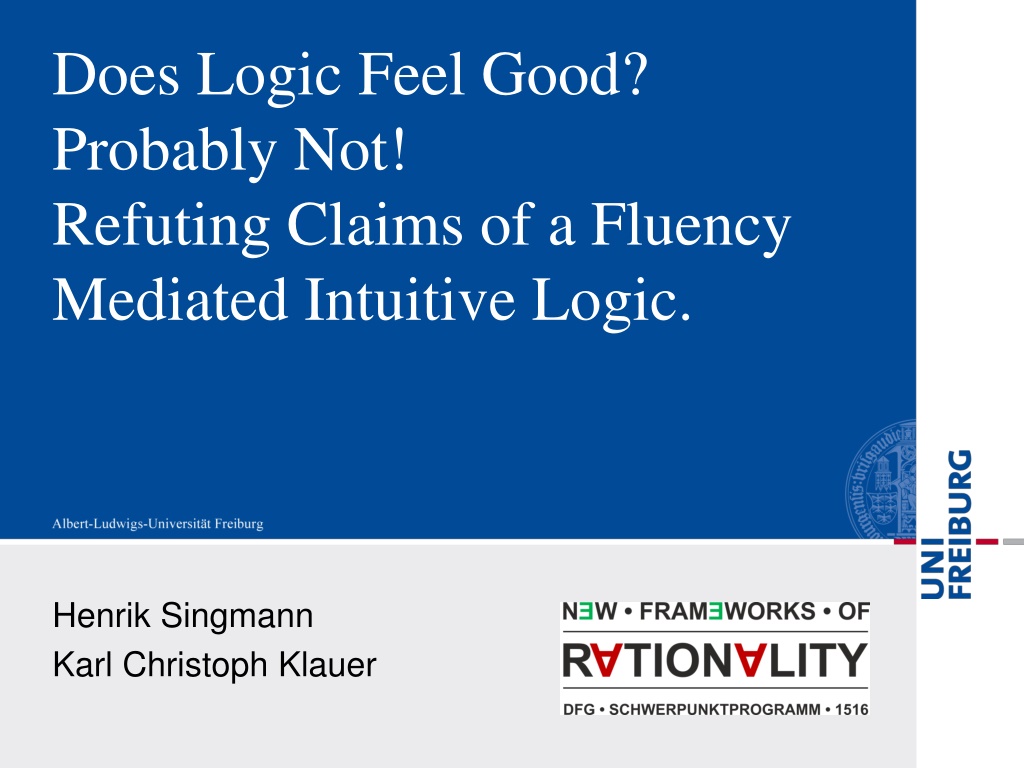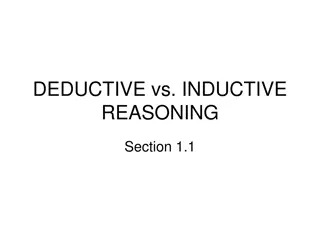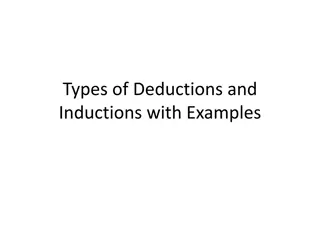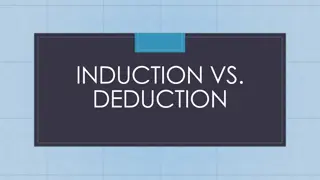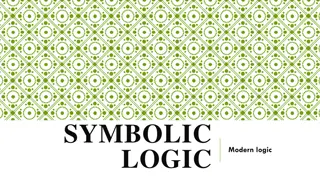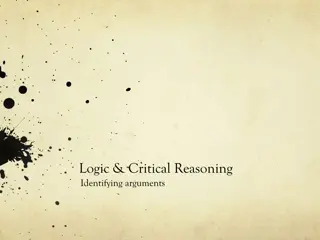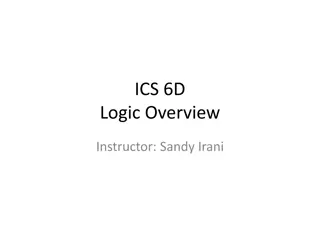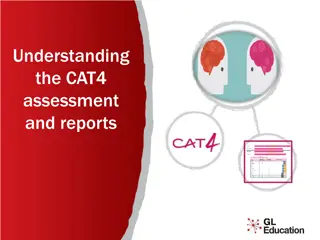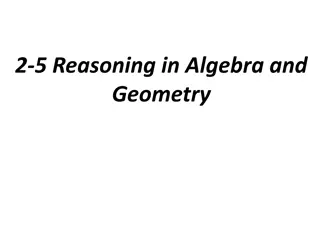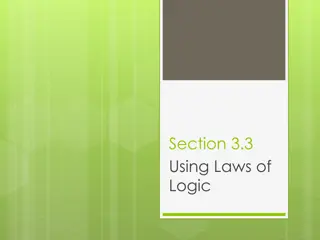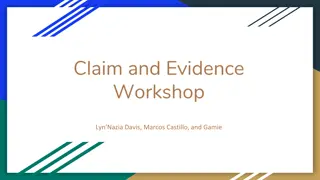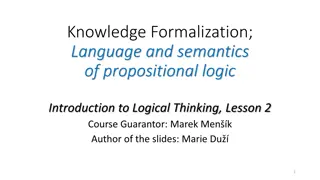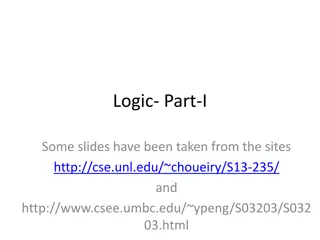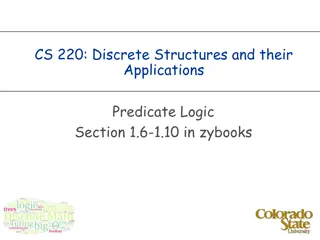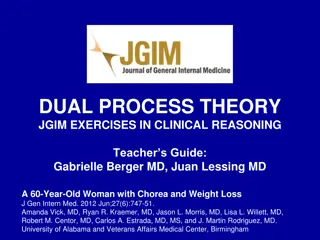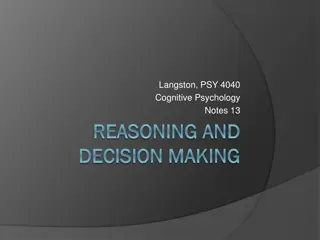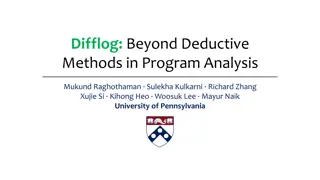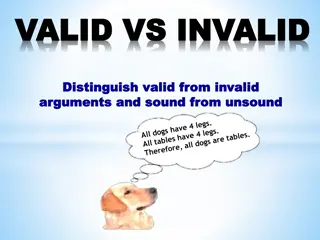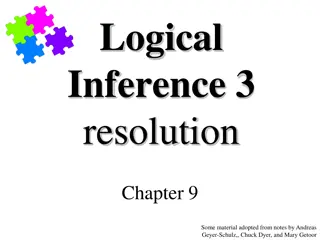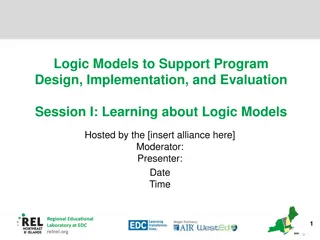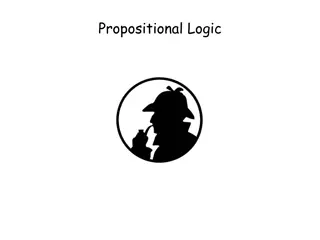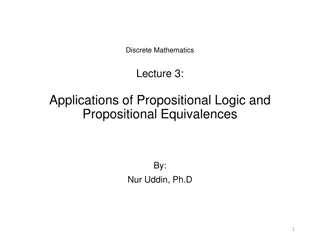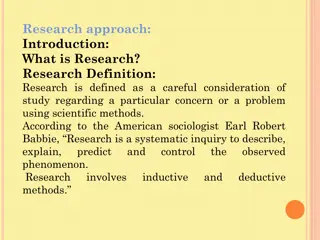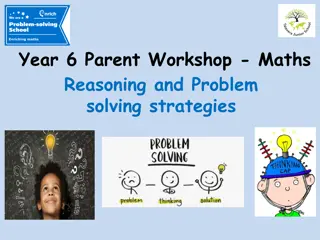Understanding Deductive Reasoning and Intuitive Logic
Deductive reasoning involves assessing the validity of arguments based on premises, while fluency-mediated intuitive logic suggests people have an intuitive sense of logicality. Challenges arise in drawing correct conclusions from abstract syllogisms, indicating a need for deliberate and effortful processing. Conceptual fluency influences how valid syllogisms are perceived, impacting cognitive responses to logical tasks.
Download Presentation

Please find below an Image/Link to download the presentation.
The content on the website is provided AS IS for your information and personal use only. It may not be sold, licensed, or shared on other websites without obtaining consent from the author. Download presentation by click this link. If you encounter any issues during the download, it is possible that the publisher has removed the file from their server.
E N D
Presentation Transcript
Does Logic Feel Good? Probably Not! Refuting Claims of a Fluency Mediated Intuitive Logic. Henrik Singmann Karl Christoph Klauer
Deductive Reasoning Deductive reasoning is concerned with the validity of arguments, the normative yardstick being extensional bivalent logic. One prominent paradigm: Testing people's ability to assess whether or not a conclusions necessarily follows from a given set of (assumed to be true) premises. People are notoriously bad in this task and influenced by numerous factors, e.g.: - Believability (Evans, Barston, and Pollard, 1983; Klauer, Musch & Naumer, 2000) - Confirmation bias (Wason, 1960) - Cognitive ability (Stanovich, 1999) 13.09.2024 2
Examples: Does it follow? No ice creams are vons. Some vons are hot. No expensive things are mets. Some mets are diamonds. Therefore, some ice creams are not hot. Therefore, some diamonds are inexpensive. 13.09.2024 3
Examples: Does it follow? No ice creams are vons. Some vons are hot. No expensive things are mets. Some mets are diamonds. Therefore, some ice creams are not hot. Therefore, some diamonds are inexpensive. invalid but believable. valid but unbelievable. 13.09.2024 4
Syllogisms b a No ice creams are vons. Some vons are hot. b No expensive things are mets. Some mets are diamonds. b a c b c Therefore, some ice creams are not hot. a c Therefore, some diamonds are inexpensive. a c invalid valid 13.09.2024 5
Syllogisms Consist of two premises (assumed to be true) and one conclusion. The conclusion contains the two terms (a and c) present only once in the premises. Meta-analysis suggests that abstract syllogisms of the form as the one presented before are especially difficult. Only 13% of participants draw the correct conclusion from those premises (IE2, Khemlani & Johnson-Laird, 2012). Most theories agree that these syllogisms can only be solved by a delibarative, effortful, and resource-demanding process (see Khemlani & Johnson-Laird, 2012, for an overview). 13.09.2024 6
Fluency Mediated Intuitive Logic Morsanyi and Handley (2012, JEP:LMC) argue that people have an intuitive sense of logicality: (see also De Neys, 2012; De Neys & Bonnefon, in press) Valid syllogisms have a larger conceptual fluency Invalid syllogisms have a lower conceptual fluency As conceptual fluency is known to increase the perceived pleasentness of stimuli (e.g., Whittlesea, 1993), valid conclusions should receive higher liking ratings. They succesfully tested these predictions in a series of four studies. 13.09.2024 7
No ice creams are vons. 13.09.2024 8
Some vons are hot. 13.09.2024 9
Some ice creams are not hot. 13.09.2024 10
How much do you like the last sentence? Therefore, some ice creams are not hot. Don't like it. Don't know. Like it. Like it very much. Don't like it at all. 13.09.2024 11
Morsanyi & Handley, Exp 4, (n = 27) ME: validity, p < .05 ME: believability, p < .05 Interaction: validity believability, p = .08 Participants give higher liking ratings for valid than for invalid syllogisms. However: Logical Status and believability/item are perfectly confounded! 13.09.2024 12
Morsanyi & Handley, Exp 4, (n = 27) ME: validity, p < .05 ME: believability, p < .05 Interaction: validity believability, p = .08 Participants give higher liking ratings for valid than for invalid syllogisms. However: Logical Status and believability/item are perfectly confounded! 13.09.2024 13
Possible Confound No ice creams are vons. Some vons are hot. Some ice creams are vons. No vons are hot. Therefore, some ice creams are not hot. Therefore, some ice creams are not hot. Syllogism is invalid, but appeared only in exactly this form. Syllogism is valid. If Morsanyi and Handley's hypotheses is true, this syllogism should receive higher liking ratings. 13.09.2024 14
Klauer & Singmann (in press), Exp. 3 In a series of studies we tested this (and an additional possible confound, not discussed here). Two conditions (with materials translated to German): - With fixed conclusion (i.e., the same material/confound as Morsanyi & Handley, 2012), n = 30 - With randomized conclusions (i.e., logical status is randomly assigned to the different contents), n = 30 Klauer, K. C., & Singmann, H. (in press). Does Logic Feel Good? Testing for Intuitive Detection of Logicality in Syllogistic Reasoning. Journal of Experimental Psychology: Learning, Memory, and Cognition. 13.09.2024 15
Klauer & Singmann (in press), Exp. 3 Replication condition: No ME of validity, p = .16 ME of believability, p = .02 But interaction of believability and validity, p < .001 (which we found of this shape in all experiments with the original materials) 13.09.2024 16
Klauer & Singmann (in press), Exp. 3 no effect of validity at all! 13.09.2024 17
Klauer & Singmann (in press), Exp. 4 To test if there really is no effect of validity with randomized contents, we replicated the randomized conclusion condition with n = 200: No ME of validity, p = .24 No interaction with validity, p = .08. ME of believability, p < .001 13.09.2024 18
Klauer & Singmann (in press), Exp. 2 Effect only due to content of the conclusion? Task: "How much do you like the last statement?" (i.e., conclusion) Replication with just the conclusion (n = 31), revealed same pattern. interaction of believability and "validity", p = .04 13.09.2024 19
New data with original material (English) Web based experiment (via crowdflower.com) with slightly different design (MH, Exp. 2), n = 22: - self-paced presentation - conclusion and second premise visible when giving liking rating - no "abstract" contents - contents not randomized We replicate the original findings: - ME validity, p = .02 - ME believability, p = .009 - no interaction, p = .88 13.09.2024 20
What if we randomize the contents? Web based experiment (identical to previous), but contents were randomized on logical status (n = 57). We replicate our findings (Exp. 3 & 4): No ME of validity, p = .72 ME of believability, p =.02 no interaction, p = .60 13.09.2024 21
Summary Morsanyi & Handley (2012) propose that validity of syllogisms can be detected intuitively via larger conceptual fluency of valid versus invalid syllogisms. Four experiments support their hypothesis. In their experiments, they did not control for content of conditional, which was confounded with logical status. When controlling for content (by randomly assigning logical status to the different contents), the effect disappears in three studies (n = 287). We do not find any evidence for their claim. 13.09.2024 22
We thank Johannes Falck for his help in realizing the randomized web experiment. 13.09.2024 23
Bayesian ANOVA With NHST difficult to gather evidence for the null Bayesian ANOVA (Rouder et al., 2012; Morey & Rouder, 2013) provides Bayes Factors for different models for the conditions with randomized contents: Model Exp 3 (rand) Exp 4 Online Meta A validity .11 .10 .08 .08 believability 1.96 1.5e+12 4.05 4.6e+14 believability + validity .21 7.9e+10 .31 1.2e+13 believability * validity .02 2.0e+10 .03 2.9e+12 Intercept only model is the reference (null model). No evidence for validity in addition to believability. 13.09.2024 24
